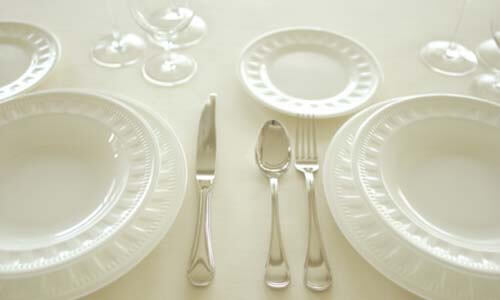Purchasing Glassware
Table Setting Guide
Before purchasing a set of glassware, consider the following.
How Often Will Your Stemware Be Used
The host who entertains often may want inexpensive glassware that goes into the dishwasher and is easy to replace.
If you entertain infrenquently, but extravegantly, you may want handmade crystal; it will require hand-washing, but the infrequent use is worth the extra care.
Long Stemmed Stemware or Short
The length of the stem creates different looks at the table.
The Weight of Stemware
The weight of stemware affects the ornamentation.
Clear Stemware or Colored Stemware
Clear Stemware
Colored Stemware
Stemware Shape and Density
The shape of the perfect wine glass is similar to an egg, longer than it is wide, a form that directs the bouquet of wine upward to the nose.
The rim is 2 to 3 inches in diameter.
The density of the ideal wine glass is paper-thin.
Matched Set or Mix and Match Stemware
At a meal where a few courses are served, a mixture of stemware adds interest. Moreover, stemware such as aperitif and cordial glasses is used away from the table. It is not seen collectively, and a mix of patterns is festive.
When a pattern is discontinued, or stock is depleted and shipments are slow, extend an incomplete set by matching it to a similar pattern in another set. Often the differences are slight. However, make sure the shapes of the bowls, the stems, and the bases are the same.
How to Mix and Match Stemware
In a set of stemware, the water goblet, the largest vessel, is the focal point of a mix-and-match collection.
In a mix of stemware patterns, keep the design of a particular piece the same for the entire table setting.
For best results keep the mix of stemware patterns two-to-one.
Keep the surface, sheen of tableware alike.
Keep tableware textures alike.
Keep the scale of stems similar.
Stemware Should Complement Dinnerware and Flatware Patterns
To establish design compatibility, take a small plate and a few utensils to the store and simulate a place setting with the chosen stemware.
The Number of Stemware Pieces per Place Setting
A suite of stemware has a minimum of three pieces: goblet, champagne glass, and wine glass.
A four-piece place setting contains a goblet, champagne glass, wine glass, and a cordial glass.
A five-piece place setting incorporates a goblet, champagne glass, wine glass, cordial glass, and iced-beverage glass.
A six-piece place setting features a goblet, champagne glass, wine glass, cordial glass, iced-beverage glass, and a second wine glass.
Open Stock
Stemware purchased by the piece, as opposed to stemware purchased by the place setting, is called open stock.
However, the least expensive way to buy stemware is by the set. To make entertainment easier to plan, purchase stemware in multiples of four, and purchase extra pieces for pattern longevity.
Handmade and Machine-made Stemware
Handmade Stemware
Machine-made stemware
Machine-made stemware is massproduced in seconds from common materials, glass recognized by uniformity of design, consistent dimensions, bulkier appearance, and ornamentation with blunt, and sometimes rounded, edges.
How to Judge the Quality of Stemware
Quality stemware is evident by:
- Smoothness,
- Balance,
- Invisible seams, and
- Uniformity of design.
To discern smoothness, run the fingers around the rim, the edge of the foot, and under the base.
Stemware with good balance rests flat on the table and does not wobble.
Invisible seams are just that-imperceptible to the eye.
Uniformity is associated with machine-made ware.
Handmade products are subject to the vagaries of human skill and exact dimensions are almost impossible to achieve; slight differences are of little concern unless they are glaringly noticeable, such as parallel lines that are not straight or a bowl that is a little larger than standard.
Allowances are made for slight variations in the glass itself and for imperfections caused by manufacture, such as:
Seeds are minute bubbles of air, about the size of a pinpoint, created by gas trapped in the material when it is mixed, melted, or fused; they give the glass "personality" when it is held to the light.
Cords are slight striae caused by an uneven furnace temperature when the material is melted or undulating marks made by tools when glass is rotated. Cords are perceptible to the touch and visible in an empty glass, but not when a glass is full.
Shear marks are slight puckers made from an overabundance of molten liquid on the pontil rod when the expanded object is cut away.
Mold marks are ridges that occur when two pieces are joined together or when the product is removed from the mold.
How to Judge Crystal
Criteria used to judge crystal:
Clarity
Clarity is apparent when stemware is held against a white background.
The higher the lead content, the greater the clarity of crystal.
Crystal with a low lead content appears cloudy and possesses a slight tint of gray, blue, or green. Crystal with a high lead content is clear.
Sparkle
Sparkle is indicative of crystal with a high lead content. Quality lead crystal possesses permanent sparkle.
Weight
Weight is determined by the amount of lead in the batch. Lead is heavy, and crystal with a high lead content is heavier than crystal with a low lead content.
Ring
Ring is determined by the shape, weight, and size of the piece.



